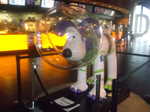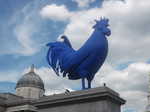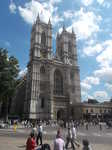Home » Adventures » Backpacking Europe » England

I visited Bristol — home of Aardman Studios, which created Wallace and Gromit. The studio was not open to the public and normally the city has nothing to offer around them, but I was fortunate as this summer a fundraiser had placed large, decorated Gromit sculptures all over town. I first headed to the mall, where several sets from Wallace and Gromit movies were on display, as well as life sized versions of some of the more famous props, including the spaceship from A Grand Day Out and mechanical trousers.
Back in town I walked all over finding statues. I was pressed for time and tried finding as many of them as I could, rather than necessarily fully appreciating the ones I located. A couple times I just took a picture and hardly even looked at the statue. Still, a few really stuck out for me, such as a pirate, Buzz Lightyear, Superman, and Where’s Wally (Waldo). I hurried all over town, competing with the large number of families and kids that were also out on this nice afternoon spotting Gromits. Every statue I found had a line of people waiting to see it and take pictures. I was about the only adult without kids, but I am used to that. Although I rushed too much, I still enjoyed my time in Bristol looking for Gromits, while their theme song played through my head most of the time. Overall I was able to get to 43 of the 80 statues that day.
I browsed the British Museum, which had a large collection of artifacts from all over the world. The Egyptian relics were most interesting to me, but wandering around the rest of the old objects was still amazing. Items from ancient Greece, Africa, Asia, and every other place were in the collection. The only downside was the place was packed (as I would later learn all of London is), partly caused by the museum at least being free.

I then visited Trafalgar Square, which was lively with its many street performers doing all kinds of different acts and many people milling about. One of the large pedestals where you would expect to find an old memorial statue had a large blue chicken atop it instead. I went inside the adjacent National Gallery, which contained many paintings, almost none of which were annoying modern art. Many were religious in nature and had a remarkable amount of detail. Old paintings can have their own trickery though, with confusing symbolic figures and other hidden meaning.
I wandered around Hyde Park, which had its nice sections, but was basically just a large park. No one was even speaking at Speakers’ Corner.

I joined in the masses outside Buckingham Palace to watch the Foot Guard in their funny hats. A couple more modern security personal with machine guns also patrolled the grounds. The Victoria Memorial out front had impressive statues and a nice vantage point to look at the palace. The Mall leading away from Buckingham Palace was adorned with large Union Jacks, the most British pride I had seen.
The South Bank of the Thames was interesting, with a great view of Britain’s House of Parliament, Big Ben1, the London Eye, and many street entertainers.

I waited through the line to enter Westminster Abby, although once inside at least it did not feel overly crowded. The the church was as ornate and luxurious as expected. Many chapels were located around the perimeter, along with the final resting place of many kings and queens. Despite the tourists, the Abby was a working church and held services and prayers throughout the day. Inside was also the graves of many famous people, among them Charles Dickens, Isaac Newton, Chaucer, and many kings and queens. Ornate headstones and monuments to the departed were all over the grounds. This location being the site of the English coronations and royal weddings was an added bonus. The coronation chair itself was not much to look at, with many scratches and without any decorations.
The Tower of London was a name well known to me, but I never really knew what it was. It ended up being basically another old castle. I took the tour with the Beefeater, who entertainingly recalled some of the tower’s history. I wandered about the complex, which was a very slow endeavor due to the large crowds. I found the exhibits on the exotic animals which used to be kept there and the graffiti from former prisoners the most interesting. I waited through the long queue to see the Crown Jewels. The collection contained the numerous crowns, robes, and scepters that are used during English coronations. The items were covered by more jewels, diamonds, and sparkling things than I could keep track of. Although The Tower of London is infamous for its prisons and torture, that was a small part of the tower’s history and most medieval castles had some type of dungeons anyway. The exhibit on the torture was unsettling in the manner of its depictions. People are (justly) outraged over torture today, but the much worse actions of several hundred years ago could be portrayed in an almost lighthearted manner without objection.
I visited the Royal Observatory in Greenwich, the site of the Prime Meridian and Greenwich Mean Time. It is basically an arbitrary line located at the point because Britain ruled the world when it was created. Still, straddling both hemispheres was a nice gimmick. The old measurement were also neat to see.
I visited Salisbury Cathedral, which had the tallest spire in Britain and an original copy of the Magna Carta. The large number of statues on the outside of Salisbury Cathedral was staggering, and I could not begin to guess who most of them were. The inside was massive, with more sculptures, stained glass, and paintings. Grave markers of important people were also all over, both inside the cathedral and on the surrounding walkways.
Only four copies of the Magna Carta remain, and this one was the best preserved, in remarkably good shape. I know it was only the first step in the transition from the absolute rule of kings to democracy, but reading the document’s translation was eye opening. Most of the provisions were still discriminatory or dealt with seemingly small grievances of the day. Whenever the Magna Carta is mentioned now, those parts are conveniently brushed aside in favor of the minority of clauses that more closely align with current values.

I went to Stonehenge, another world famous historic site that was not earth shattering to see in person. It was impressive though, and I never appreciated how large the stones really were. The pillars towered over my head and a third of their mass was still buried underground. They were even constructed using mortise and tenon joints to keep the stones in place and transported hundreds of miles to their current site. Stonehenge was also built very precisely, with its orientation aligning with the seasons. All this work was done by a people that disappeared, for a purpose that is no longer certain.